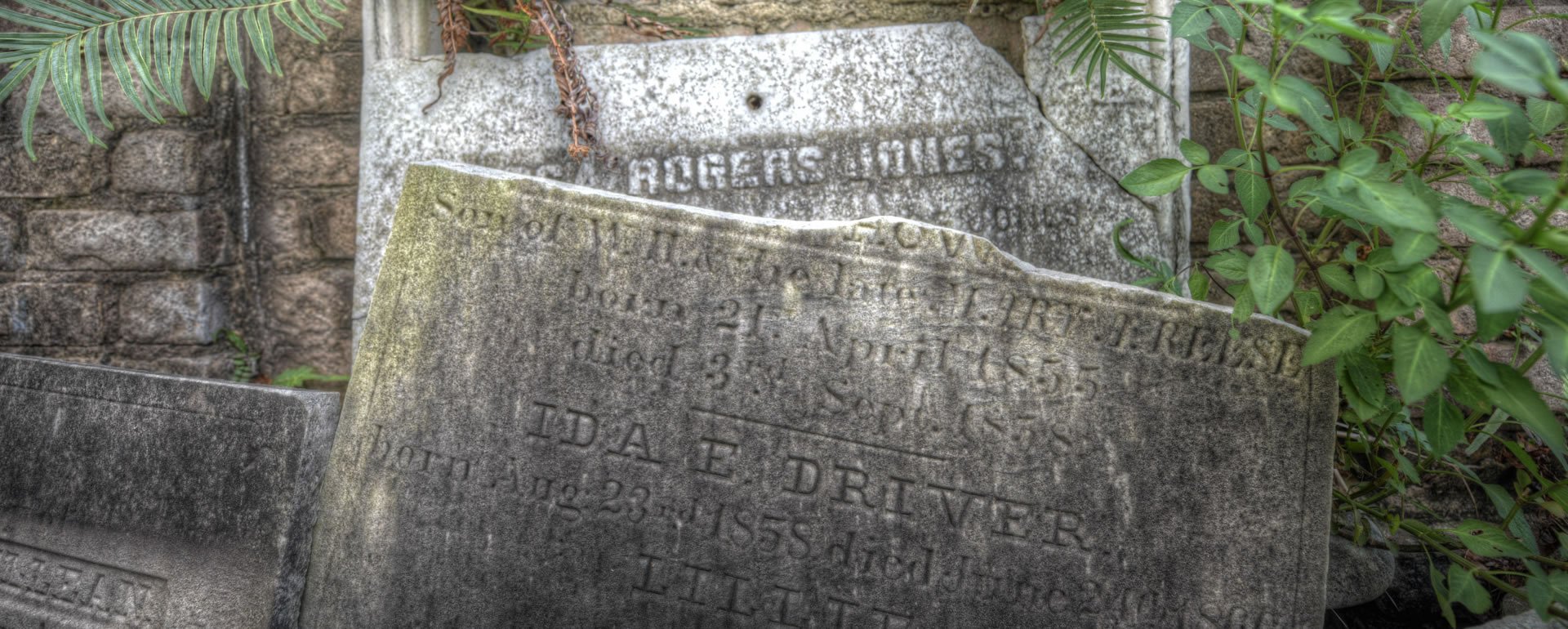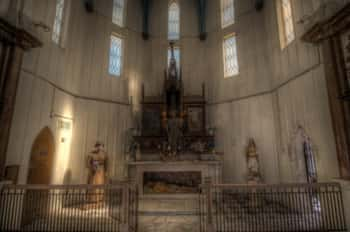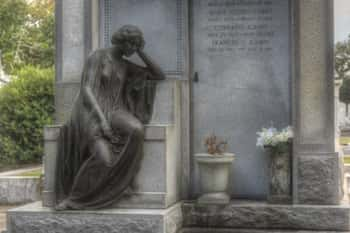
For the quintessential New Orleans experience, take the St. Charles streetcar at Canal St. in the French Quarter and head towards the Garden District. Get off at Washington Ave. Walk two blocks (or stop at my favorite coffee shop Still Perkin’ for a cafe au lait first), and you’ll be standing in front of Lafayette Cemetery nestled in the middle of an absolutely beautiful Garden District neighborhood lined with Live Oak trees. Take a look across the street and you will see the infamous turquoise and white striped awning of Commander’s Palace, one of New Orleans best, award-winning, and world renowned restaurants.
The pale brick walls of Lafayette #1 lead you to the arched wrought iron gates of the Washington Ave. entrance. Step back in time as you enter the main path, flanked with blooming magnolia trees. Take a look around this haunted cemetery and its labyrinth of historical crypts. Say hello to one of New Orleans’ most famed cities of the dead.
A non-denominational, non-segregated cemetery, and the oldest of the seven municipal, city-operated cemeteries in New Orleans, Lafayette #1 was named for the City of Lafayette and established in 1833. It was the first cemetery in the city where non-Catholics could be buried, and contains over 26 nationalities.
Lafayette #1 was designed by Benjamin Buisson, city surveyor, and acquired from Cornelius Hurst, holder of the Livaudais Plantation. The plantation was subdivided into city squares in 1832 and sold to the city. Following its annexation by New Orleans in 1852, the city of Lafayette in Jefferson Parish no longer exists and is simply known today as the Garden District. Lafayette was a city of transplants, composed mainly of German and Irish-born citizens and their children. The Garden District and its grand mansions were later established by the New Orleans American elite in the late 1840s who wanted to seperate themselves from the Creoles and the hustle and bustle of the French Quarter.
The formal, four quadrant grounds of Lafayette #1 take up an entire city block and house around 1,100 family tombs and more than 7,000 people. In its hay day, there was an abundance of fragrant and beautiful flowers adorning its narrow alleyways, and with its cross-shaped pattern, gave a park-like atmosphere that was especially enjoyed on All Saints’ Day.
Within decades of its opening (thanks to the likes of yellow fever), this beautiful Southern Gothic cemetery was filled to capacity with coping tombs, internment chambers, mausoleums, crypts, and society tombs. It is currently maintained by Save Our Cemeteries Inc., and was placed on the National Register of Historic Places in 1972.
Death by yellow fever took the lives of thousands of New Orleanians and aided in the mass occupancy of Lafayette #1. Reading many of the inscriptions on the tombs of the departed, you will see “died of yellow fever” more times than you can count.
The residents of the Garden District spaced their gardens and homes far apart, thinking this would protect them from the Saffron Scourge. What happened instead was a virtual breeding ground for mosquitoes, created by their reflecting pools, bird baths, and cisterns filled with standing water. After decades of complete devastation to the population, the residents’ efforts to thwart this horrible disease proved futile when it was discovered that yellow fever was spread by the Aedes aegypti mosquito.
Between the years of 1817 and 1905, when the last epidemic hit the nation, more than 40,000 people died in the Crescent City. In 1853 alone, nearly 9,000 of the city’s 154,000 inhabitants perished after almost 30,000 contracted the disease. There was anywhere between 150-250 funerals per day that year, a great number of them in Lafayette #1.
A three to four foot underground coping wall made of stone or brick was built where the pine box was placed. In Victorian times, it was popular to be buried with the soil of your home state or country. This was the way it was done in Lafayette cemetery #1, and the dirt was shipped in and used to cover the casket.
Wall vaults, or “internment chambers”, serve as the walls of Lafayette cemetery #1. They provided a less cost-prohibitive alternative to building a private family tomb. I like to call them the “apartments” as opposed to the “private estates”. There are approximately 500 wall vaults in Lafayette #1.
A closure tablet is the stone slab on the front of an above ground crypt that is engraved with the names of the deceased. When a tablet is filled or replaced, or the family sells their crypt, the slab is put on the side of the tomb to make room for the new stone. The Smith-Dumestre tomb in Lafayette #1 has 37 names inscribed on its closure tablet, and is supposedly awaiting 10 more.
Society tombs became common with immigrant ethnicities such as German, Irish, Italian, and Hebrew (check out the German Presbyterian Community tomb in Lafayette #1). Later, benevolent associations, fraternal groups, charities, military, police, fireman, etc used this highly efficient form of internment as a way to make the aftermath of death less taxing. People often did not have the money for their own family tombs so this was a way of having “burial insurance”. Below are some of the society tombs located in Lafayette #1:
The Independent Order of Odd Fellows’ (IOOF) purpose is “visit the sick, relieve the distressed, bury the dead, and educate the orphan”. They have a society tomb here in Lafayette #1 that where were allowed to be buried after paying membership dues.
The New Orleans Home for Incurables was a place of refuge for the disabled and gravely ill. They were generally left and forgotten about by their own families. A society tomb was created to offer them a final, peaceful resting place.
The Society for the Relief of Destitute Orphan Boys (now known as the Waldo Burton Memorial Home) was a much needed charity in the time of yellow fever. It provided resources and housing for orphaned boys, and this societal tomb as their final resting place.
The Jefferson Fire Company tomb is the largest of three volunteer firefighter companies’ societal tombs in Lafayette #1.
This fraternal monument, which you will see throughout Lafayette #1, has four objects carved into it: a maul, an axe, a wedge, and a dove. The organization was known to have done volunteer work in the local communities.
The McLellan-Fayesoux tomb has a broken column as its centerpiece which makes it hard to miss. A son of the family, who was killed in action in the Civil War, is memorialized with this monument. It is said that the family wanted to be buried in the soil of their home state, which was brought in to create this raised family graveyard you see today.
There are many famous and infamous inhabitants of Lafayette #1 Cemetery in the Garden District. Here are just a few:
(April 14th, 1820 - August 21st, 1876) Hays was a distinguished confederate general who led the first Louisiana Brigade in the Civil War, playing a major role in the Battle of Gettysburg.
(June 10th, 1838 - November 12th, 1915) Judge Ferguson was known for the Plessy vs. Ferguson “separate-but-equal” case that took place in 1896 in New Orleans during the Reconstruction era of the south after the Civil War.
The Brunies were a musically talented family famous for their associations with The New Orleans Rhythm Kings, Papa Laine, the Halfway House Club of New Orleans, Louis Prima, and the Dixieland revival. Merritt, George, and Albert are all interred here in Lafayette #1 among their other family members.
Better known as “Lestat’s Tomb” thanks to author Anne Rice, this cast-iron structure is one of only 16 of its kind in New Orleans, and the only one in Lafayette #1. The Wood and Miltenberger Company that made these “customized” tombs also manufactured the cornstalk fences you see around the French Quarter and Garden District today.
As the most filmed cemetery in New Orleans, Lafayette #1 is host to many movie/tv scenes, author inspirations, and even music videos. The likes of Mark Ruffalo, Ryan Reynolds, and Samuel Jackson have been spotted inside. I even hear that Jimmy Page and Robert Plant used to frequent the tree lined pathways!
The movies Double Jeopardy (1999) and Dracula 2000 (2000) had scenes set on these hallowed grounds. The CW Network’s The Originals and NCIS: New Orleans along with music videos by LeAnn Rimes and New Kids on the Block (“The Right Stuff”) have been filmed here as well.
It is no secret that Anne Rice was heavily influenced by Lafayette #1 having lived only a few blocks away. The Mayfair Witches of The Witching Hour and Interview with a Vampire’s crypts were modeled from the Jefferson fireman tomb and the Karstendiek family tomb respectively. She also staged her own jazz funeral to promote her book Memnoch the Devil.
Lafayette #1 Cemetery is located at 1416-1498 Washington Ave., New Orleans, LA 70131 and is open seven days a week from 7am-3pm. Closed most holidays. It is free to enter and open to the public.

Where a ghost dog is seen

New Orleans' most haunted Cemetery

New Orleans' most grand Cemetery